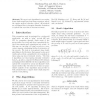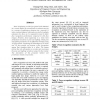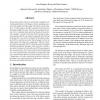CRV
2005
IEEE
15 years 6 months ago
2005
IEEE
: We report on 4 algorithms for recovering dense depth maps from long image sequences, where the camera motion is known a priori. All methods use a Kalman filter to integrate inte...
99
Voted
CRV
2005
IEEE
15 years 6 months ago
2005
IEEE
A fundamental task in computer vision is that of determining the position and orientation of a moving camera relative to an observed object or scene. Many such visual tracking alg...
111
Voted
CRV
2005
IEEE
15 years 6 months ago
2005
IEEE
The problem of elucidating the functional significance of genes is a key challenge of modern science. Solving this problem can lead to fundamental advancements across multiple are...
105
Voted
CRV
2005
IEEE
15 years 6 months ago
2005
IEEE
The work presented here solves two major problems of hand pose recognition: (A) determining what pose is shown in a given, input picture and (B) detecting the presence of a known ...
118
click to vote
CRV
2005
IEEE
15 years 6 months ago
2005
IEEE
This paper proposes a novel method for estimating depth from a long image sequence captured by a moving camera. Our idea for estimating a depth map is very simple; only counting i...
123
click to vote
CRV
2005
IEEE
15 years 6 months ago
2005
IEEE
Face recognition in video has gained wide attention as a covert method for surveillance to enhance security in a variety of application domains (e.g., airports). A video contains ...
90
Voted
CRV
2005
IEEE
15 years 6 months ago
2005
IEEE
In this paper, we develop a new tracking approach which is based on cooperation and coordination of multiple agents which are pan-tilt-zoom cameras to optimize the cost of trackin...
131
Voted
CRV
2005
IEEE
15 years 6 months ago
2005
IEEE
We present an approach to recognizing faces with varying appearances which also considers the relative probability of occurrence for each appearance. We propose and demonstrate ex...
119
Voted
CRV
2005
IEEE
15 years 6 months ago
2005
IEEE
In this paper we describe a technique to infer the topology and connectivity information of a network of cameras based on observed motion in the environment. While the technique c...
100
Voted
CRV
2005
IEEE
15 years 6 months ago
2005
IEEE
We present an object detection system that is applied to detecting pedestrians in still images, without assuming any a priori knowledge about the image. The system works as follow...



